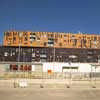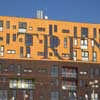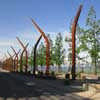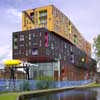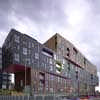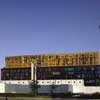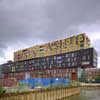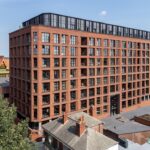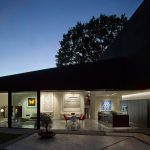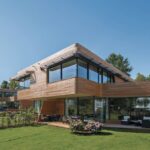Chips Flats, Manchester Apartment Building, Will Alsop Ancoats Property, Images
Chips Manchester New Islington
Building in Ancoats : New Islington Housing, northwest England property design by Alsop Architects
post updated 26 Jan 2021 ; 1 May 2011
Chips New Islington
Chips New Islington – Photos © Adrian Welch, May 2011:
Residential Development in Ancoats
ALSOP’S RESIDENTIAL DEVELOPMENT ‘CHIPS’ COMPLETES IN MANCHESTER
Quirky, bold and robust, ‘Chips’ forms the first major development for the Alsop Architects-designed masterplan for New Islington in Manchester, UK.
Location: Ancoats, just northeast of city centre
Photographs : Christian Richters
New Islington, Manchester’s Millennium Community, is situated between the Ashton and Rochdale canals on the Northern edge of Manchester City Centre. Launched in 2002, Alsop Architects’ Strategic Framework for New Islington, lays out an exceptional place, modelled around new canal arms and an inspiring landscape.
Commissioned by Urban Splash in 2002, Chips presents the first new apartments for sale in New Islington. Designed by Alsop Architects, the building was inspired by three fat chips piled on top of one another. The building comprises three equal-height, long, thin new build masses (Chips) approximately 100m long by 14m wide stacked and staggered upon one another creating an elevated ground floor and eight levels comprising 142 one, two and three bedroom apartments.
The building is clad in a composite wall, faced with a cladding covered in newspaper print with text that echoes the industrial heritage of the local area.
The design provides a mix of living and studio units and commercial space within a single project. The project defines a quality of living by combining outstanding design with technological innovation while embracing key concepts of sustainability, integration into the urban landscape and the provision of inspirational and sensational apartment units.
The building’s apartment types range from studio spaces to three bed apartments. There is also a variety of differing external balconies. The apartments are planned internally around a central ‘pod’ unit, housing the bathroom and kitchen areas. The apartments can be open plan or sub-divided by the use of large folding screens.
The scheme achieves a BREEAM Eco-Homes Excellent rating, conforms to the Manchester Methodist Housing Trust scheme’s stringent development standards and also meets the Sustainability guidelines as set out by the UK Homes and Communities agency as apart of the ‘millennium community’ programme.
The completion of Chips marks another significant milestone for New Islington, which will become even more of a community once the residents of Chips move into their apartments in 2009.
Chips Manchester – Project Team
Client: Urban Splash Ltd
Architect: Alsop Architects
Main contractor: Urban Splash Build Ltd
Structural engineer: Martin Stockley Associates
M&E consultant: Quartzelec
Quantity surveyor: Simon Fenton Partnership
Landscape Designer: Grant Associates
Lighting designer: Pinniger & Partners
Acoustic consultants: Buro Happold
Approved inspector: HCD
Architectural project team (Alsop Architects): Will Alsop, Duncan Macaulay, Edward Norman, Caroline Koo, Bonny Yu
Chips – Project Description
Chips: Ancoats, Manchester UK
Introduction
Chips is a 9-storey, 16,200 m² gross contemporary residential development, providing a mix of living, studio and restaurant spaces. Alsop Architects was appointed to design the building by Urban Splash in 2002 following the completion of Alsop Architects’ Strategic Framework for the New Islington area in Manchester, UK.
Themes contained in the New Islington development address issues such as environmental sustainability, social inclusion, new housing typologies and creating a sense of place and destination.
Site and context
The site for Chips forms part of the New Islington Strategic Framework area to the Northeast of Manchester City centre. The overall site, which is a brownfield site, is bounded on the Northwest by Redhill Street and the Rochdale canal; on the Northeast by waste ground north of Woodward Place and by Weybridge road and Carruthers Street; on the Southeast by the Ashton Canal; and on the Southwest by Cardroom Road and Vesta Street.
Specifically, the Chips site is the portion of the above area formed on a peninsula directly north of and enclosed on the southern face by the Ashton Canal. Additional canal arms have been constructed to the east and west of the site enclosing it with water on three sides.
The Chips site is long and thin, 28m wide at its widest point and approximately 120m long. It accommodates a level change of approximately 2.5 metres along its length with the southwest tip being the lowest and the northeast the highest point of the site.
An Ancoats hospital ward block was previously located on the site; these buildings and part of the adjacent Stubbs Mill building were demolished to make way for the new development.
Consultation
Alsop Architects developed the scheme in close collaboration with the local community. Using the Alsop Architects strategy of engagement, the masterplan and Chips building design were developed from an extensive community consultation exercise over a six-month period. Local residents were taken on site visits to high-density residential developments that support the sustainable infrastructure that the community wanted. In addition, Alsop Architects led workshops where the residents were directly asked what type of accommodation they wanted and the facilities that they felt the community would require. The final design is a direct result of the consultation process.
Alsop Architects Design
The ambition for Chips was to create a high quality, high-density affordable development, the scale of which was reduced by the juxtaposition of the massing of the architecture. The scheme was conceived to give variation and unique apartments within a high-density block. An important part of the design strategy was that all residents would be near water, able to see water and to be able to use the new canal arms as a recreational facility. The mix of apartments, studios, workshops and restaurants stitched into the overall building form creates a diversity of use. The building was raised off the ground so that all units and users are elevated above the ground plain.
The building is constructed using a concrete frame which inherently assists with the acoustic and fire protection performance of the development and allows the apartments to have exposed concrete soffits. Externally, the building uses a rain screen façade clad in composite Trespa panels. The panels allow for a diverse range of colours to be used and indeed for the large-scale text to be applied to the façade.
Residential Accommodation
The apartments are arranged on eight floors above ground either side of a central corridor running East/ West through the building. The building accommodates six main apartment types labelled A to F and includes a mix of types ranging from studio spaces to 3-bed apartments. Creating a socially inclusive building, affordable and market housing apartments are distributed randomly throughout the building without differentiation.
The principle idea of the apartments was to reduce the amount of unused circulation area and to make the apartments open plan, flexible and generous. Most apartments are planned internally around a central ‘pod’ housing the bathroom and kitchen areas. This is treated as an object within the main apartment space. The apartment volume can be open plan or sub-divided by the use of large folding screens. The pods within the apartments also house all the electrical and servicing requirements of the unit freeing the outer walls from switches, pipes and clutter. Large and varied window shapes give variation and maximise daylight.
The pods are pre-fabricated with factory-finished components and surfaces to contrast with the more robust ‘industrial’ finishes to the internal elevations.
Chips Manchester Building layout
Entrances
An important part of Alsop Architects’ design was to create a building that has one front door for all residents – all apartments are accessed via a glazed lobby to the centre of the building which is accessible to mobility impaired individuals.
The studio spaces at ground level have their own individual entrances and the restaurant area has its entrance on the west short elevation.
Ground floor
The ground floor encompasses a central triple-height entrance lobby for the apartments accessible from the North and South elevations of the building. The ground floor also houses a 420m² restaurant with kitchen and function room entered from the West elevation and six studio spaces accessed from the north elevation ranging from 44 to 110 m².
The ground floor level is elevated 1.5m above the groundscape on the North elevation and to the Southwest corner of the building. This allows space for natural venting from the car park area below. The building has a raised walkway to the north face and to part of the Southern face which gives the potential for external dining to the restaurant area and also provides the entrances to studio spaces and the main entrance lobby to the apartments.
A series of steps and ramps allow all users access to the raised walkway.
Level 01
Level 01 contains 14 apartments distributed from the entrance lobby via the central corridor. The double-height restaurant space below has been achieved by omission of three apartments from this floor plan in the Northwest corner of the floor plate.
A high level walkway at the lobby area spanning across the glazed triple height lobby space sub divides the accommodation on the floor plan. As with each of the Chips floor plans the long, cranking façade to the north and South elevations gives the apartments a unique aspect and varies the type and size of accommodation.
Level 02
The top floor of the bottom chip is the first residential floor plan to utilise the entire building footprint and houses 17 apartments including a number of apartments with inset balconies. A high level walkway over the lobby area divides the accommodation into East and West sections.
Levels 03/04/05
The middle chip is the longest at 113 m long and houses the majority of the residential accommodation (66 apartments; 22 per floor). Balconies and window types and positions are distributed in differing positions on each floor plate giving the unique elevation pattern to the building. The middle chip cantilevers over the bottom chip at the East and West ends of the building creating a dramatic glazed entrance lobby to the restaurant entrance area.
Levels 06/07/08
The top chip is the shortest in length at approx. 80m long and accommodates 45 apartments in total over the 3 floors. It houses a 3-bedroom apartment on each floor at the Southwestern corner maximising on views and daylight. Having a smaller floor plate than the middle chip means that at level 06 there is a space for a large communal roof terrace to the East of the building and additional external balcony provision for 2 flats at the West end of the development.
The 3 differing size and position of the floor plates to the bottom, middle and top chips gives the building the distinctive staggered stacked chip form.
Basement
The building incorporates one basement level. It is anticipated that the combined provision for car parking under the Chips building and the proposed adjacent building will facilitate a 1 space per apartment unit parking ratio. Additionally a 10% provision is given for disabled parking. The basement also houses all of the major plant areas for the building, bicycle parking area and waste/ refuse store areas.
Chips Manchester – Building Information
Total m² (gross internal area): 16,200 m²
Total project Cost: £20m
Building location: Ancoats, Manchester
Building height: 34 metres to roof parapet
Total number of storeys: 9 plus basement
Chips Manchester – Building Programme
Alsop Architects Commissioned 2002
Date start on site Jan 2006
Completion Jun 2009
Chips Manchester images / information from S&R
Location: Chips New Islington, Manchester, Northwest England, UK
Manchester Buildings
Contemporary Manchester Architecture
Manchester Architecture Walking Tours
Manchester Architecture – Selection:
Addington Street Housing, New Cross
Design: Hawkins\Brown Architects
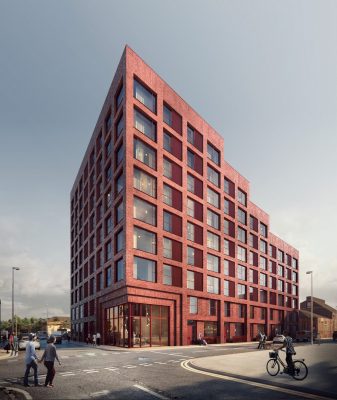
image courtesy of Far East Consortium (FEC)
Addington Street Housing
Manchester Civil Justice Centre
Comments / photos for the Chips Manchester Flats – Ancoats Homes page welcome

